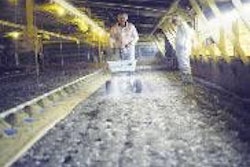The theme for last month was ‘mixed signals.’ Many feared that public concerns and the bad press about avian influenza (AI) would depress demand for poultry and negatively impact jobs and expansion. Although these concerns still linger, expectations concerning future conditions improved substantially.
Ignoring last quarter—which may have been an anomaly—the Overall Index has hovered around 90 (baseline=100), indicating a slight pessimism regarding the overall condition of the poultry industry. However, decreasing confidence in the present situation offset by an increasing optimistic outlook created this midpoint. The data for this quarter continued that pattern.
The Overall Index held steady at 86.5 (up from last quarter, but similar to the estimate in the two previous quarters). The Present Situation Index decreased to 66.8 from 76.7, the lowest number in three years, while the Expectations Index rose from 75.5 to 99.5.
It’s fairly obvious to most observers why the current situation received such a low score. As pointed out last quarter, the AI situation looms over the industry like a dark cloud, potentially affecting exports and consumption. This created some of the lowest prices in recent years due to oversupply.
However, there are some positive signs that could prove to be the breakthrough we need to get everything back in the black. Across the world, and especially in the United States, many of our respondents felt that AI was losing its hold on consumers. Although still talked about in the media, many noted that the frequency and intensity of the media stories had subsided. The public can only be scared so long until they get bored.
As one respondent said, though, “It all depends on AI and its impact. If it doesn’t show up, I think more product will move and prices will recover.” Just a day or so ago, however, a few weeks after the last survey had reached this office, a low-pathogenic strain of H5 was discovered in Canada. If a highly-pathogenic strain migrates to the United States, all bets are off as I’m sure this would set off a media frenzy.
Because of the poor economic conditions, integrators appear to have finally become serious about reducing the supply. As one respondent said, “Cut production, it is Economics 101.” For the last thirteen weeks or so, broiler egg sets have been below year-ago levels and placements have followed suit. (If you want to track broiler egg sets and placements on a weekly basis, see http://tinyurl.com/qxpqk.) For example, John Bekkers of Gold Kist recently announced that the company had an across-the-board cut in production of 3.5 percent.
This tactic has recently paid off in higher prices. Georgia Dock prices for Whole Breasts have risen 12 cents per pound since the middle of last quarter while Leg Quarter prices have nearly doubled to 33.5 cents over the same time period. (If you want to track Georgia Dock Prices on a weekly basis, see http://tinyurl.com/rbz45.) Futhermore, exports have not suffered as some expected when the Russians cancelled all their import permits. Key groups like the USA Poultry & Egg Export Council did an excellent job of keeping the trade routes open during this situation.
Summary. There is reason to be optimistic about the future situation, as integrators seem determined to better manage supply and demand. The result has been a drastic improvement in prices; profits should follow. The lower profile of the AI situation should help make their job easier, although a return of AI to a higher level of consciousness could easily turn everything sour again.

















